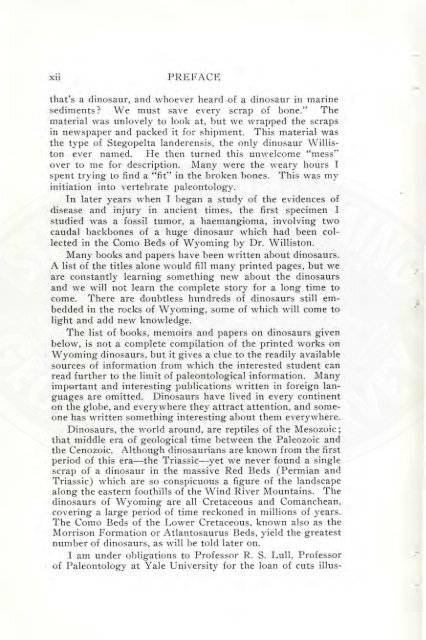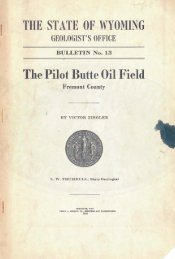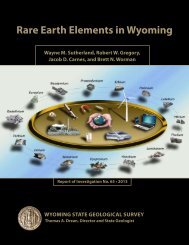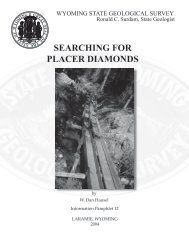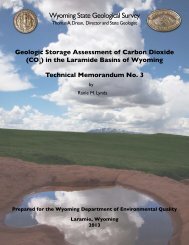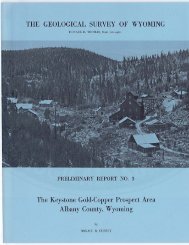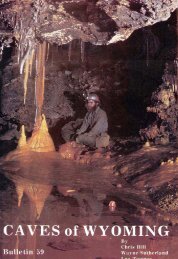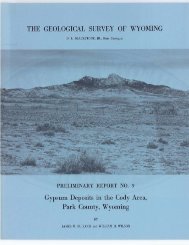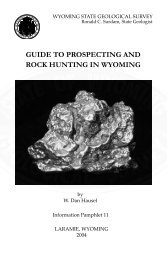The Dinosaurs of Wyoming - Wyoming State Geological Survey ...
The Dinosaurs of Wyoming - Wyoming State Geological Survey ...
The Dinosaurs of Wyoming - Wyoming State Geological Survey ...
You also want an ePaper? Increase the reach of your titles
YUMPU automatically turns print PDFs into web optimized ePapers that Google loves.
xu PREFACE<br />
that's a dinosaur, and whoever heard <strong>of</strong> a dinosaur in marine<br />
sediments? We must save every scrap <strong>of</strong> bone." <strong>The</strong><br />
material was unlovely to look at, but we wrapped the scraps<br />
in newspaper and packed it for shipment. This material was<br />
the type <strong>of</strong> Stegopelta landerensis, the only dinosaur Williston<br />
ever named. He then turned this unvvelcome "mess"<br />
over to me for description. Many were the weary hours I<br />
spent trying to find a "fit" in the broken bones. This was my<br />
initiation into vertebrate paleontology.<br />
In later years when I began a study <strong>of</strong> the evidences <strong>of</strong><br />
disease and injury in ancient times, the first specimen I<br />
studied was a fossil tumor, a haemangioma, involving two<br />
caudal backbones <strong>of</strong> a huge dinosaur which had been collected<br />
in the Como Beds <strong>of</strong> <strong>Wyoming</strong> by Dr. Williston.<br />
Many books and papers have been written about dinosaurs.<br />
A list <strong>of</strong> the titles alone would fill many printed pages, but we<br />
are constantly learning something new about the dinosaurs<br />
and we will not learn the complete story for a long time to<br />
come. <strong>The</strong>re are doubtless hundreds <strong>of</strong> dinosaurs still embedded<br />
in the rocks <strong>of</strong> <strong>Wyoming</strong>, some <strong>of</strong> which will come to<br />
light and add new knowledge.<br />
<strong>The</strong> list <strong>of</strong> books, memoirs and papers on dinosaurs given<br />
below, is not a complete compilation <strong>of</strong> the printed works on<br />
<strong>Wyoming</strong> dinosaurs, but it gives a clue to the readily available<br />
sources <strong>of</strong> information from which the interested student can<br />
read further to the limit <strong>of</strong> paleontological information. Many<br />
impQrtant and interesting publications written in foreign languages<br />
are omitted. <strong>Dinosaurs</strong> have lived in every continent<br />
on the globe, and everywhere they attract attention, and someone<br />
has written something interesting about them everywhere.<br />
<strong>Dinosaurs</strong>, the world around, are reptiles <strong>of</strong> the Mesozoic;<br />
that middle era <strong>of</strong> geological time between the Paleozoic and<br />
the Cenozoic. Although dinosaurians are known from the first<br />
period <strong>of</strong> this era-the Triassic-yet we never found a single<br />
scrap <strong>of</strong> a dinosaur in the massive Red Beds (Permian and<br />
Triassic) which are so conspicuous a figure <strong>of</strong> the landscape<br />
along the eastern foothills <strong>of</strong> the Wind River Mountains. <strong>The</strong><br />
dinosaurs <strong>of</strong> <strong>Wyoming</strong> are all Cretaceous and Comanchean,<br />
covering a large period <strong>of</strong> time reckoned in millions <strong>of</strong> years.<br />
<strong>The</strong> Como Beds <strong>of</strong> the Lower Cretaceous, known also as the<br />
Morrison Formation or Atlantosaurus Beds, yield the greatest<br />
number <strong>of</strong> dinosaurs, as will be told later on.<br />
I am under obligations to Pr<strong>of</strong>essor R. S. Lull, Pr<strong>of</strong>essor<br />
<strong>of</strong> Paleontology at Yale University for the loan <strong>of</strong> cuts illus-


